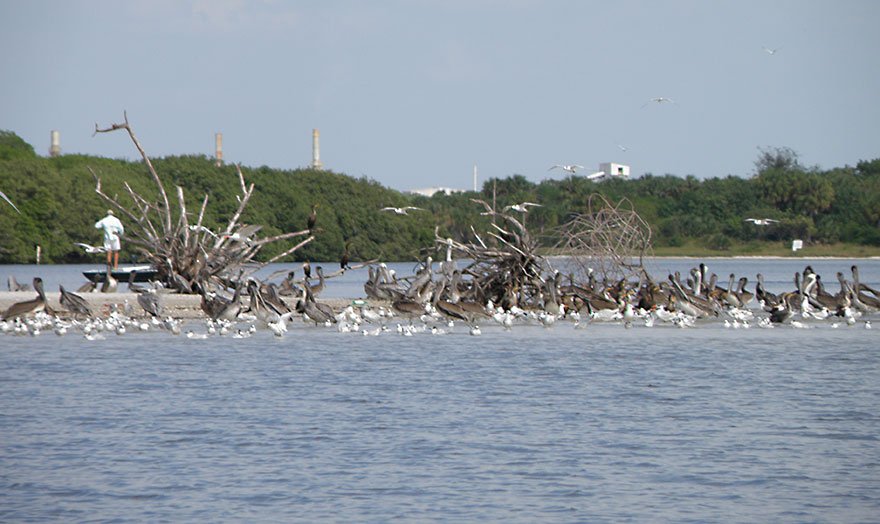The courses, offered in Pinellas, Hillsborough and Manatee counties, consist of 40-hour programs with in-depth information on the natural places that make Florida so unique. Some of the students are experts looking for certification, but most are just interested people who want to learn more about the habitats and wildlife in this amazing state.
“We get people who are just curious, people who want to be docents in our parks or preserves, some college students – and even college professors – who want to expand their knowledge about Florida habitats and wildlife,” notes Jeanne Murphy, senior wildlife biologist for Sensing Nature and lead instructor for the Master Naturalist program in Pinellas County.
Unlike the Master Gardener program, which is also run under the auspices of the University of Florida, the Master Naturalist program follows a more consistent program so that people from Miami can learn about ecosystems in their part of the state in a Tampa Bay area class, she adds.
“We probably offer more classes every year than any other county, so a lot of people will travel from Miami, for instance, to take the coastal class here.”
The program includes three core modules – covering freshwater wetlands, coastal systems and upland habitats – plus four special topics designed to address specific needs, including environmental interpretation, conservation science, and courses in monitoring wildlife and habitat.
They were originally developed by Martin Main, a professor and ecologist in the Department of Wildlife Ecology and Conservation at the University of Florida beginning in 1999 after he recognized the need for a professional development education program.
“I believe that most people are genuinely interested and concerned about nature, and that as they learn more, their level of interest and concern increases,” he said. “I was surprised, however, at the tremendous response to the FMNP, which I think is a very good indication that Floridians will work hard to ensure healthy environments, clean water, and diverse wildlife are available for future generations to enjoy.”
Although Florida was the first in the country to create a Master Naturalist program, other states are replicating the efforts. “It’s particularly important here though, because so many people move to Florida from other places,” adds Dolly Cummings, director of Camp Bayou in Ruskin and lead instructor for Hillsborough County. “There’s nowhere else in the world like Florida,” she says. “I was a Girl Scout leader and national parks volunteer, so I spent a lot of time outdoors before I moved here, but I’ve never learned so much as I have since I’ve been here.”
Classes are available at various times and places across the region, depending upon who is leading them. It can be challenging to sign up online though, because UF leaves only a two-week window shortly before the course begins. “The thinking is that they don’t want people to sign up, then forget that they have, and ask for their money back,” says Lisa Hickey, the urban horticulturist and water conservation specialist for Manatee County who also holds a degree in biology and leads local Master Naturalist programs.
She suggests that potential participants contact instructors and ask to be notified when plans are final, even before the information goes online. “It’s challenging for some people to come up with 40 hours, so we want to give them enough time to figure out how to make that happen,” she said. “As instructors, we can let people know what’s being planned, when it’s finalized and when they can get online to schedule it.”
Fall, winter and spring are the top seasons for Master Naturalist programs because they’re set up to be about half classroom and half outdoor work. “We try to do field trips to places people might not visit otherwise – we avoid preserves with 50 million tourists,” Hickey adds.
People who complete the programs understand more about the unique challenges facing Florida as the state’s population continues to grow – and tend to share their knowledge through formal organizations like the Audubon Society or Sierra Club, as well as standing in a grocery store line.
“The more people who take the classes and learn the ecology, the better off we’ll all be as a state,” says Murphy.
Learn more:
The cost to participate in each 40-hour course is $225 and includes a two-volume set of detailed course materials.
[su_row] [su_column size=”1/3″]Hillsborough County
Camp Bayou Outdoor Learning Center
4140 24th Street SE
Ruskin, FL 33570
FMNP Contact: Dolly Cummings
Email: campbayou@yahoo.com
Phone: 813-641-8545
Courses Offered: Coastal Systems, Freshwater Wetlands, Upland Habitats
Manatee County
UF/IFAS Manatee County Extension
1303 17th Street West
Palmetto, FL 34221
FMNP Contact: Lisa Hickey
Email: lisa.hickey@ufl.edu
Phone: 941-722-4524 ext. 238
Courses Offered: Coastal Systems, Freshwater Wetlands, Upland Habitats
Pinellas County
Sensing Nature
FMNP Contact: Jeanne Murphy
Email: jmurphy@sensingnature.com
Phone: 727-397-2306
Courses Offered: Coastal Systems, Freshwater Wetlands, Upland Habitats, Conservation Science, Environmental Interpretation, Habitat Evaluation, Wildlife Monitoring
